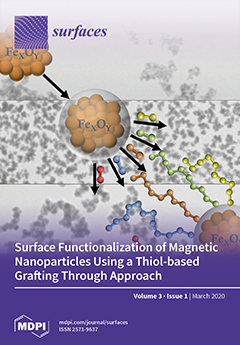In the present study, we use commercial digitally printed ceramic tiles, functionnalized by AgNPs doped micro–TiO
2, to investigate the mechanism of Ag in the continouos photocatalytic antibacterial activity. The novelty of the research lies in the attempt to understand the mechanism of Ag, supported on TiO
2, able to exhibit the same antibacterial activity of a standard system containing Ag species, but here, totally embedded on the tile surface, and thus not free to move and damage the bacteria cell. UV/vis diffuse reflectance spectroscopy (DRS) of AgNPs–TiO
2 tiles indicated an enhanced visible light response, wherein a new absorption band was produced around 18,000–20,000 cm
−1 (i.e., in the 400–600 nm range) owing to the surface plasmon resonance (SPR) of AgNPs. The antibacterial photocatalytic experiments were conducted towards the inactivation of
E. coli under solar light and indoor light. It was found that the degradation speed of
E. coli in the presence of AgNPs–TiO
2 tiles is solar light-intensity depending. This justifies the semiconductor behavior of the material. Furthermore, the AgNPs–TiO
2 tiles exhibit a high ability for the inactivation of
E. coli at a high load (10
4–10
7 colony-forming unit (CFU)/mL). Additionally, AgNPs–TiO
2 tiles showed a remarkable antibacterial activity under indoor light, which confirms the good photocatalytic ability of such tiles. On the basis of the reactive oxygen species (ROS) quenching experiments, O
2•− species and h
+ were more reactive for the inactivation of
E. coli rather than
•OH species. This is because of the different lifetime (bacteria are more likely oxidized by ROS with longer lifetime); in fact, O
2•− and h
+ exhibit a longer lifetime compared with
•OH species. The generation of H
2O
2 as the most stable ROS molecule was also suggested.
Full article





